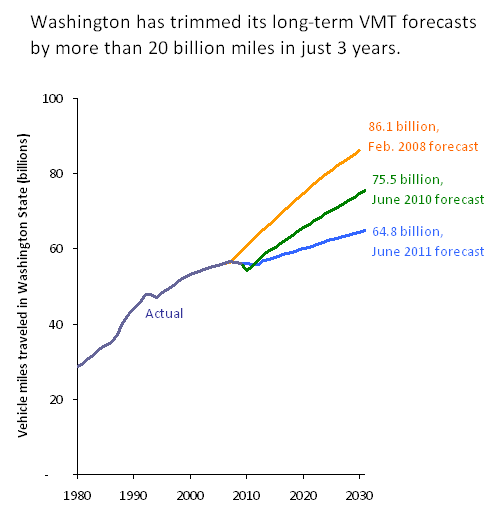According to the most recent forecasts from the Washington State Office of Financial Management, drivers in Washington State will rack up about 65 billion miles on the highways in 2031.
I have no idea if that number is anywhere close to accurate. Nobody does. But what I do know is that the current estimate is 21 billion miles lower than the forecast that OFM made 3 years ago, and more than 10 billion miles lower than their forecast from just last year. The chart has the details:

It’s awfully tempting to suggest this chart shows that OFM is gradually groping towards more realistic traffic projections.
But does it, really? To be honest, I don’t actually know if the blue line is more “realistic” than the orange line. Sure, the blue line is more consistent with the actual traffic trends over the last decade—a period when annual VMT growth slowed to a crawl. But I don’t have a crystal ball that tells me which of the three lines is the most “realistic” depiction of the future.
Instead, I think the real lessons of the chart lie elsewhere.
The first lesson is this: nobody has any special insight into the future. Future VMT trends aren’t a feature of objective reality that smart people can sit in a room and puzzle out. They’re just guesses. Sometimes new information comes in, and the guesses change. Sometimes they change radically, enough to make the best guesses from a year earlier look ludicrous. So it’s important to remember that even if particular forecast matches up with your world view, it’s still just a guess.
Which leads to a second lesson: nobody should take official VMT forecasts too seriously. Three years ago, the “official” guess was that there would be lots of new demand for road space, and lots of new gas tax revenue to pay for it. Today, the “official” guess is that statewide gas consumption peaked in 2002 or 2003, never to rise again; that gas tax revenues are going to decline unless the state ramps up the tax rate; and that the demand for new road space is going to slow to a crawl. Those are two completely contradictory views from the same agency in the same political administration. So all the hot air that was spewed about the dire need for new transportation megaprojects to avoid the near-certainty of a trafficopalypse showed nothing more than hubris, overconfidence, and a dismal understanding of how forecasting actually works.
And there’s a third lesson here: forecasts can be dangerous. People have a tendency to take official forecasts awfully seriously. But the decisions we made three years ago that we “had” to put lots of new megaprojects into the pipeline, based on forecasts of massive gridlock in 20 years, could very easily turn out to be dreadfully costly mistakes. When we place too much confidence in any one forecast, we can wind up making terrible decisions.
To me, the rapid change in traffic forecasts argues for a new way to think about transportation investments: that we make them smaller, more versatile, more nimble, more creative, and less likely to lock us into huge long-term expenses for projects that we might not actually need. In short, it argues for an approach that’s the exact opposite of all the multi-billion dollar bridges, tunnels, and highway expansions that are on the docket in the Northwest.

Comments are closed.